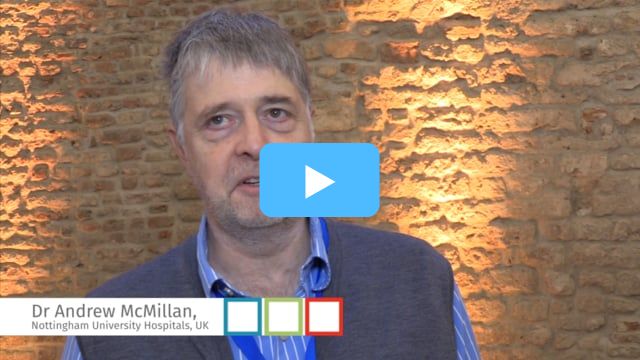Advertisment
Advanced stage disease

As survival with frontline chemotherapy has steadily improved for patients with advanced Hodgkin lymphoma several studies have looked at how far short- and long-term toxicity can be reduced without loss of effect. Experts presented updates on three of the landmark studies …
Dr Andrew McMillan (Nottingham) talks about his take-aways from the HD18 trial presentation.
ECHELON 1 was a Phase 3, open-label, randomised study of brentuximab vedotin (BV) (1.2 mg/kg) + AVD (6 cycles) versus ABVD (6 cycles) in patients with advanced Hodgkin lymphoma (HL). The trial was designed before data from the RATHL study were available, so PET-adaptation was not built into the protocol, noted the presenter, Professor John Radford (Manchester, UK). The primary endpoint was ‘modified PFS’ (mPFS) that included progression, death but also a ‘non complete response’, indicated by a Deauville score of 3 or more, and subsequent anticancer therapy, in order to capture failure of frontline therapy, he explained.
The two-year mPFS (per independent review facility (IRF)) was 82.1% (95% CI: 78.7 – 80.5%) in the BV+AVD group and 77.2% (95% CI: 73.7 – 80.4%) in the ABVD group with a hazard ratio (HR) of 0.77 (95% CI: 0.60 – 0.98).
However when analysed in the usual way, the two-year PFS (per investigator) was 84.2% (95% CI: 81.1 – 86.9%) in the BV+AVD group and 78.0% (95% CI: 74.4 – 81.1%) in the ABVD group with a HR of 0.711 95% CI: 0.522 – 0.968)
The probability of two-year overall survival did not differ between groups – 96.6% BV+AVD vs 94.2% ADVB.
Further analysis showed that in the BV+AVD group 33% fewer patients required subsequent chemotherapy or stem cell transplants. There was more neutropaenia in the experimental arm. Granulocyte colony stimulating factor (GCSF) was not included in the original study protocol and when it was introduced all grades of treatment emergent adverse events (TEAEs) decreased resulting in a safety profile “comparable to that of ABVD”, said Professor Radford.
Peripheral neuropathy (PN) was more common in the BV+AVD group but mostly resolved afterwards. Interstitial lung disease – attributable to bleomycin – was a notable feature of ABVD treatment. In addition, deaths during and after treatment were more frequent in the ABVD group.
When compared to ABVD, the BV+AVD treatment significantly extended the time until progression, death or need for subsequent anticancer therapy in patients without a CR at the end of therapy, concluded Professor Radford.
Dr Andrew McMillan (Nottingham) talks about his take-aways from the HD18 trial presentation.
HD18 update
Intensive frontline therapy in advanced stage HL using escalated BEACOPP is superior to ABVD because the PFS difference translates into an overall survival difference of 10% at five years, argued Professor Peter Borchmann (Cologne, Germany). However, about 70% of patients with advanced HL can be cured with ABVD alone and if they could be selected on the basis of early metabolic response overtreatment might be avoided. Therefore, the HD 18 study assessed PET-guided therapy of advanced HL. After two cycles of eBEACOPP PET/CT scans were centrally reviewed; PET positive patients were assigned to either six cycles of eBEACOPP (Arm A) or one cycle of eBEACOPP and five cycles of rituximab-eBEACOPP (Arm B) . PET-negative patients were assigned to either six cycles of eBEACOPP or two cycles of eBEACOPP.
The first finding was that the addition of rituximab made no difference to PFS – the five-year PFS values were 88.1% (95% CI: 83.5-92.7%) in the rituximab arm compared with 89.7% (95% CI: 85.4-94.0%) in the eBEACOPP alone arm. When the trial was designed it had been assumed that the five-year PFS would be 68% in these patients and that rituximab would improve this to 83%, commented Professor Borchmann.
In the PET-negative, low-risk group the non-inferiority of four cycles of eBEACOPP was established. Five year PFS estimates were 91.8 (95% CI 89.0-94.6%) for four cycles compared with 91.2% (95% CI: 88.5 – 94.0%) for 6-8 cycles. Moreover, there was much less toxicity with four cycles compared to six or eight (treatment-related morbidity (TRM) of 41% vs 61-66%) and this also translated into less secondary neoplasia. Overall survival was better with four cycles of eBEACOPP than with six-eight cycles. Moreover, HL as a relevant cause of death had been eliminated, said Professor Borchmann.
However, some open questions remained including that of the cut-off value for PET2-positivity. The HD18 trial used Deauville scores (DS) of 3 and 4 as PET-positive but a re-analysis of the results showed that DS 1-3 were associated with low probabilities of early relapse and disease progression whereas DS 4 is associated with much higher probability of early relapse. Only a DS 4 at PET2 indicates increased risk of early treatment failure with German Hodgkin Study Group (GHSG) standard treatment and allows identification of those patients who really need intensive treatment. PET2 DS1-3 has a high negative predictive value and applies to 75% of all patients treated with eBEACOPP. They benefit from a short, safe and effective treatment. The balance of risks and benefits of using eBEACOPP up front in a personalised, PET-guided strategy makes it an attractive option for newly diagnosed, advanced stage HL patients, concluded Professor Borchmann.
LYSA AHL 2011
Another study in advanced HL – LYSA AHL 2011 presented by Dr Olivier Casasnovas (Dijon. Fr) – also tackled the question of whether interim PET might identify a subset of patients suitable for de-escalation of treatment (from eBEACOPP to ABVD) without impairing disease control. In this study PET positivity was defined as DS 4 and above. The results showed that in patients who were PET-negative after two cycles of BEACOPP treatment could be continued using four cycles of ABVD with no loss of effect but less toxicity.
Based on presentations given at the 11th International Symposium on Hodgkin Lymphoma, October





